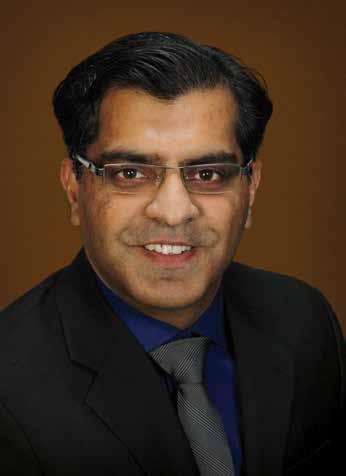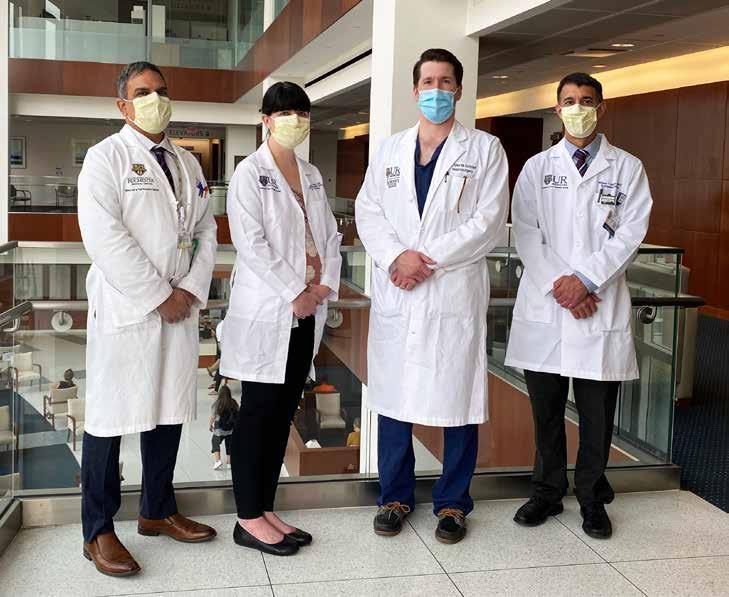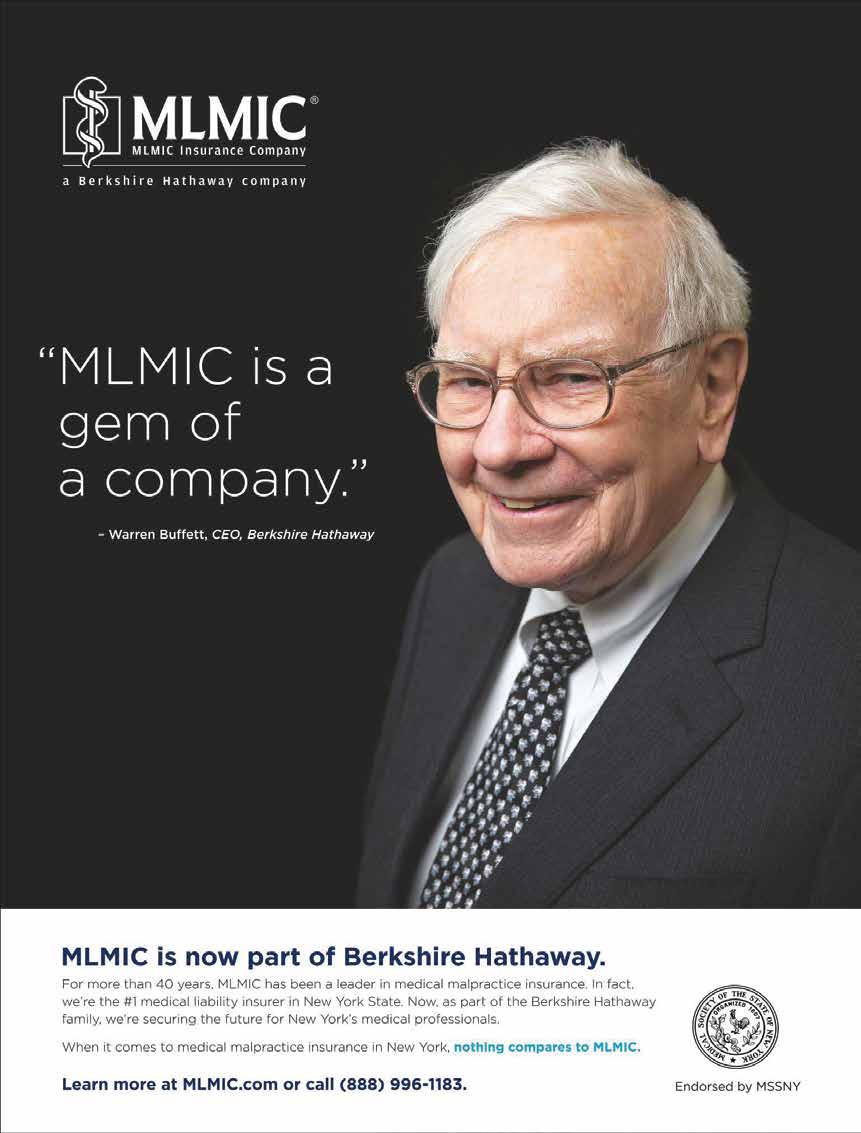
5 minute read
Specialty Profile
RRH Practice Provides Novel Methods for Fighting Cancer Pain
Randi Minetor
Advertisement
Hemant Kalia, MD, MPH

Much medical research focuses on innovative ways to make many forms of cancer curable, or at least livable with long periods of remission. Treating cancer’s symptoms remains the top priority in oncology practices throughout western New York, however, especially for Hemant Kalia, MD, MPH, whose practice at Rochester Regional Health focuses on comprehensive cancer pain management and rehabilitation medicine. “Over the last decade, there has been a lot of advancement in our understanding of different pain generators and novel sites of pain modulation that can lead to both acute and chronic pain in cancer patients,” he said. “By using technology, we can use precision medicine, and be very specific in managing their type of cancer pain.”
Finding new ways to treat chronic, disease-related pain has become a significant priority in light of the epidemic of opioid addiction across the country, said Dr. Kalia. “When we use highly potent opioid medication by mouth, it goes through your entire body before it works on the actual pain receptors in your spine. The reward and pain centers are very closely linked in our brains; chronic use of potent opioids through oral route can stimulate both these centers, which leads to tolerance, dependence and addiction. We now have an evolutionary method of delivering medications directly around the spinal cord to provide much more effective and durable pain control without significant systemic side effects in our cancer patients.”
This method of targeted drug delivery, bringing medications directly to the spinal cord where most pain receptors are concentrated, is used in Dr. Kalia’s practice. “We bypass the patient’s gut, so most of the systemic side effects of taking medications by mouth are negated,” he said. “Patients get more targeted and elegant pain control without all the side effects.”
New treatments developed and approved for use in the last five years allow physicians to control pain by reaching selected nerves with either ultrasound or x-ray guidance, either to deliver pain-reducing drugs or to stimulate the nerves to block the pain signal.
One treatment, called neuro-modulation, involves the placement of a tiny wire with electrodes directly around either the nerves or spinal cord, to block the pain signals originating at the cancer site. “We can block the pain without using any
medication,” he said. “This blocks the peripheral nerve or the spinal cord, thereby improving pain and quality of life.”
An added benefit to patients is that these are minimallyinvasive procedures that do not require general anesthesia or a hospital stay. “These are 15-20 minute procedures performed in our offices,” Dr. Kalia said.

Chemical neurolysis, another treatment method that has been available for quite some time, uses dehydrated ethyl alcohol or phenol under ultrasound guidance to destroy the nerve and eliminate the pain signal, he continued. “For example, a patient with multiple metastatic lesions in the spine may be struggling with intractable back pain and unable to do activities of daily living. With the help of x-ray guidance and using tiny needles, we can access that lesion in the spine, burn it, and fill the cavity with cement, and help ameliorate the patient’s symptoms.” Patient-controlled intrathecal analgesia also succeeds for many patients with cancer pain, he said. The physician inserts a catheter directly into the patient’s spinal canal and connects it to a pump reservoir, which the patient can use to administer the medication in the reservoir when he or she feels pain. “This gives the control of managing pain back to patients without the risk of addiction or overdose, as the medication is delivered directly around the patient’s spine with the help of a pump. There are checks and balances – if they are having additional pain, they have a controller and can give themselves additional doses of medication to manage breakthrough pain. This is further controlled by the limits the doctor sets on the pump.”
The medication goes directly to the source of the pain rather than through the patient’s entire body, avoiding the potential for addiction and side effects, he said. “This is different from giving a patient a 30-day supply of the medication and risking overdose.”
Why, then, are they not used more widely?
These pain-reducing therapies have been considered for some time, Dr. Kalia noted, but in the last decade they have become more streamlined, and the number of physicians trained to perform them has increased. “There are very few training programs in the country which focus specifically on advanced cancer pain management,” he said, but this is not the only obstacle to widespread use. “The drawbacks are insurance coverage – we don’t have extensive reimbursement codes for the procedures. So we are limited to using old codes for reimbursement,” which limits the access to these therapies. “We are working through our national society advocacy groups, have lobbied and tried to convince CMS (Centers of Medicare Services) and other private insurance companies to cover these procedures that can allow patients to continue their treatments and improve their quality of life.” Beyond these therapies, cancer pain care involves an interdisciplinary team, with multiple specialties working together on the patient’s behalf to provide optimum care, he said. “What we offer is a comprehensive approach to pain management. We not only help cancer patients manage their pain, but also its impact on their social life and their mental state. We have psychologists who help cancer patients deal with their chronic pain using behavior modification techniques. We have physical and occupational therapists, and we also work very closely with our palliative care specialists, oncologists, and social workers. They all come together hand in hand to develop a patient-centered plan of care.”
The practice draws patients from throughout the greater Rochester area, and as far away as Batavia and Medina to the west, Clifton Springs and Wayne County to the east, and southward through the Southern Tier to the Pennsylvania border. “For some of the really advanced therapies, we are the only site to offer them in upstate NY,” he said. “It started at Unity Hospital, and after we became a big family of five hospitals under Rochester Regional Health, it was not only our moral obligation but a duty to offer our life altering therapies across the region. We look forward to continuing to provide our comprehensive cancer pain management and rehabilitation services to our community members.”
Randi Minetor is the author of Medical Tests in Context: Innovations and Insights (Greenwood, 2019), and is a freelance journalist based in Rochester.









